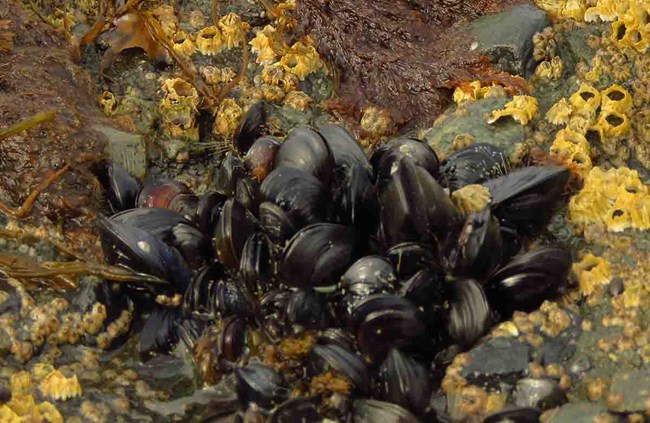Last updated: April 9, 2018
Article
Mussel Abundance in the Gulf of Alaska

Variation in abundance of Pacific Blue Mussel (Mytilus trossulus) in the Northern Gulf of Alaska, 2006–2015
Abstract
Mussels are conspicuous and ecologically important components of nearshore marine communities around the globe. Pacific blue mussels (Mytilus trossulus) are common residents of intertidal habitats in protected waters of the North Pacific, serving as a conduit of primary production to a wide range of nearshore consumers including predatory invertebrates, sea ducks, shorebirds, sea otters, humans, and other terrestrial mammals. We monitored seven metrics of intertidal Pacific blue mussel abundance at five sites in each of three regions across the northern Gulf of Alaska: Katmai National Park and Preserve (Katmai; 2006–2015), Kenai Fjords National Park (Kenai Fjords; 2008–2015) and western Prince William Sound (WPWS; 2007–2015). Metrics included estimates of: % cover at two tide heights in randomly selected rocky intertidal habitat; and in selected mussel beds estimates of: the density of large mussels (≥ 20 mm); density of all mussels > 2 mm estimated from cores extracted from those mussel beds; bed size; and total abundance of large and all mussels, i.e. the product of density and bed size. We evaluated whether these measures of mussel abundance differed among sites or regions, whether mussel abundance varied over time, and whether temporal patterns in abundance were site specific, or synchronous at regional or Gulf-wide spatial scales. We found that, for all metrics, mussel abundance varied on a site-by-site basis. After accounting for site differences, we found similar temporal patterns in several measures of abundance (both % cover metrics, large mussel density, large mussel abundance, and mussel abundance estimated from cores), in which abundance was initially high, declined significantly over several years, and subsequently recovered. Averaged across all sites, we documented declines of 84% in large mussel abundance through 2013 with recovery to 41% of initial abundance by 2015. These findings suggest that factors operating across the northern Gulf of Alaska were affecting mussel survival and subsequently abundance. In contrast, density of primarily small mussels obtained from cores (as an index of recruitment), varied markedly by site, but did not show meaningful temporal trends. We interpret this to indicate that settlement was driven by site-specific features rather than Gulf wide factors. By extension, we hypothesize that temporal changes in mussel abundance observed was not a result of temporal variation in larval supply leading to variation in recruitment, but rather suggestive of mortality as a primary demographic factor driving mussel abundance. Our results highlight the need to better understand underlying mechanisms of change in mussels, as well as implications of that change to nearshore consumers.
Bodkin, J. L., H. A. Coletti, B. E. Ballachey, D. H. Monson, D. Esler, and T. A. Dean. 2017. Variation in abundance of Pacific blue mussel (Mytilus trossulus) in the northern Gulf of Alaska, 2006-2015. Deep Sea Research Part II: Topical Studies in Oceanography DOI: 10.1016/j. dsr2.2017.04.008.
